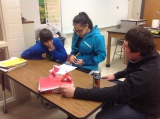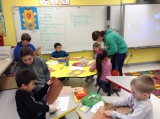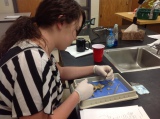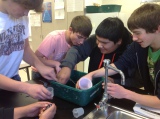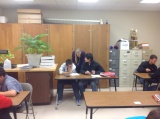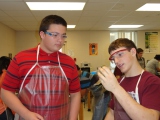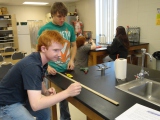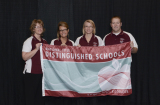-
Category 2
Selected in 2013
-
Grades: 9 - 12
School Setting: rural
Town Population: 443
Student Enrollment: 93
Student Demographics:
Black/African American: 0%
Teacher/Student Ratio: 1:8
White/Caucasian: 38%
Hispanic: 0%
Hawaiian/Pacific Islander: 0%
Asian: 0%
Native American: 62%
Other: 0%
% Reduced Lunch: 35%
% ELL Learners: 0%
Founded: 1910 -
PRINCIPAL:
Julie Marshall -
CONTACT:
PO Box 1000
Timber Lake, SD 57656
605-865-3654
julie.marshall@k12.sd.us
Timber Lake High School
Timber Lake, SD
We have a program called Caring School Climate. The components of this are promoting respect, giving students a sense of belonging, decreasing bullying behaviors, building developmental assets and developing service learning.
- Describe the most successful activity your school has initiated to strengthen ties to your community.
- Our Backpack Program is the program that has strengthened our ties to the community. Several years ago, an environmental science class was studying world hunger. This study led them to discuss hunger in our community and to prepare a service learning project called Operation Backpack. High school students volunteer to put together "backpacks" of food each Friday to send home with elementary students who may not have food available to them over the weekend. Items for the backpack program and funds for it are provided by our community. The local grocery store posts signs that recommend certain food items for the program. Patrons may purchase the groceries at the store and drop them off there or bring them to the school. The Timber Lake community has been very supportive of this endeavor with several area groups conducting fundraisers to support the program.
- Describe the program or initiative that has had the greatest positive effect on student achievement, including closing achievement or opportunity gaps, if applicable.
- We have recently implemented a program called ICU. Just as a hospital has intensive care for sick patients, we have ICU for students with "sick" grades. Each week, we run an eligibility report that identifies students who have a GPA of below 2.0 or an F in any class. These students are first put on a warning list and after two weeks put on an ineligible list. At the beginning of the week, parents are informed and asked to help support their student. These students are required to stay after school at least two days during the school week to receive extra help in the class in which they are struggling. The teachers in our district are willing to come early in the morning, stay after school and sometimes give up their preparation periods to work with these students and improve their grades. Our guidance counselor also touches base with each student individually to give encouragement and help when needed. This program has significantly decreased the number of at risk students.
- Explain how Title I funds are used to support your improvement efforts.
- Title I funds are used in our district for teacher salaries. By using our funds to employ highly qualified teachers, we are able to put the best people possible with our students. Because of our rural area, these funds allow us to keep our salary competitive and encourage teachers to become part of our school and community.
- Identify the critical professional development activities you use to improve teaching and student learning.
- This year our professional development activities have hinged on a concept called Professional Learning Communities (PLCs). Teachers were divided into grade level and content area teams with a teacher facilitating each group. We have two full day inservices and five 1/2 day inservices in which our PLC groups can focus on improving student achievement within their teams. There are three big ideas of the PLC concept. First, groups must focus on learning. The fundamental purpose of schools is to ensure all students learn at high levels. Second, there must be focus on collaborative teamwork. Ensuring that all students learn requires us to work together to meet their needs and find the best ways to educate our children. Thirdly, we must focus on student achievement. We all want students to be successful. PLC's are no different and the focus must be work to increase student achievement. Engaged students are learning students, learning students are achieving students.
- Describe how data is used to improve student achievement and inform decision making.
- Data driven decisions are essential in improving student achievement. Over the past three years, we have developed a team of teachers from across grade level and curriculum and dubbed them our Data Leadership Team. This team meets in the fall to analyze data from our Dakota STEP and ACT scores. With this and expertise from the Data Leadership Team, we are able to formulate goals and a plan of action to achieve those goals for the district. The leadership team then conducts an inservice with the entire staff to get input on the goals. We are then able to focus our inservice times throughout the year around the goals set by the leadership team based upon the data analysis. Our district has also conducted surveys of students, staff, parents, community members and alumni to get feedback on our instructional practices. In the classroom, teachers use formative and summative assessment to design their instruction and be reflective educators.
- Describe your school culture and explain changes you’ve taken to improve it.
- School climate is an essential component to school success. We have several programs that help enhance this. First, we have a program called Caring School Climate. The components of this are promoting respect, giving students a sense of belonging, decreasing bullying behaviors, building developmental assets and developing service learning. This is built through activities, lessons and staff attitudes and promotion of the program. Students meet and watch videos about character building. They are able to write and discuss their reactions and opinions to these videos and how they apply to real life situations. Next, we have a group of students called Peer Helpers. This group is in charge of welcoming new students and helping them become acclimated to our school, conducting conflict mediation sessions, and building a caring climate with their attitudes in the school. If a student is hospitalized or has a loss, the Peer Helper group will design cards and messages to encourage.
Stats
-
Category 2
Selected in 2013
-
Grades: 9 - 12
School Setting: rural
Town Population: 443
Student Enrollment: 93
Student Demographics:
Black/African American: 0%
Teacher/Student Ratio: 1:8
White/Caucasian: 38%
Hispanic: 0%
Hawaiian/Pacific Islander: 0%
Asian: 0%
Native American: 62%
Other: 0%
% Reduced Lunch: 35%
% ELL Learners: 0%
Founded: 1910 -
PRINCIPAL:
Julie Marshall -
CONTACT:
PO Box 1000
Timber Lake, SD 57656
605-865-3654
julie.marshall@k12.sd.us


